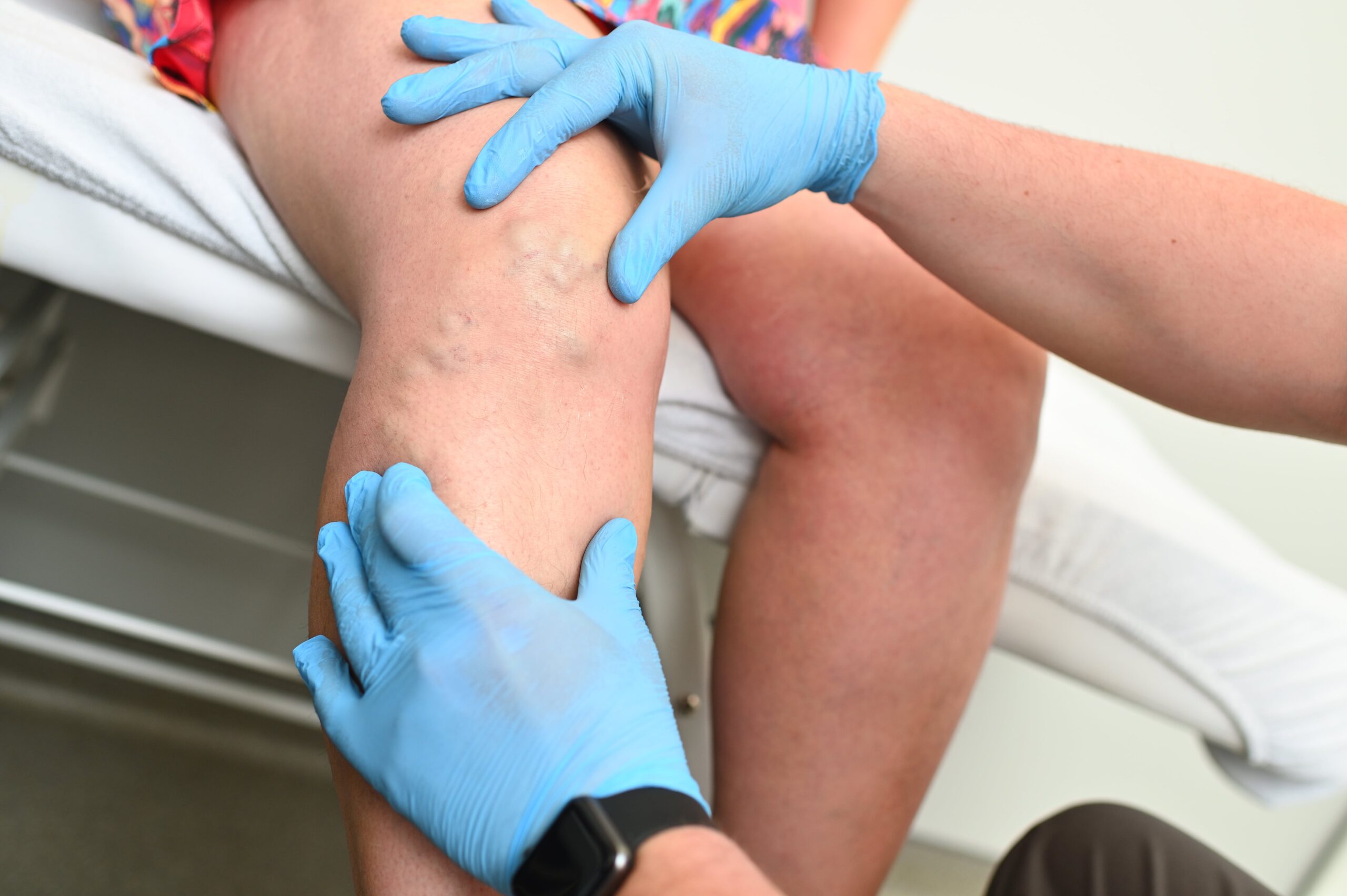By: Dr. Dev Batra | 09.10.25
Have you ever been to the doctor with leg pain and heard them mention the Homans’ sign test? You’re not alone: it’s an old-school test still used in some clinics today, especially for people at risk of deep vein thrombosis (DVT). But while it’s quick and simple, a positive Homans sign isn’t always a reliable diagnosis.
So, what exactly is the Homans sign, how is it used postpartum, and should you be concerned if you test positive? Let’s break it down in a way that actually makes sense.
What Is the Homans’ Sign Test?
The Homans’ sign is a basic physical exam used to check for potential blood clots – specifically, deep vein thrombosis in the leg. To perform the test, a healthcare provider gently flexes your foot upward (called dorsiflexion) while your leg is straight or slightly bent at the knee. If this movement causes sharp pain or tenderness in the calf, it’s considered a positive Homans’ sign.
It’s easy and non-invasive, but also a bit outdated.
A Brief History of Homans’ Sign
The Homans’ sign test is named after Dr. John Homans, an American surgeon and pioneer in vascular medicine who first described the maneuver in the 1940s. At the time, there were few tools available to detect deep vein thrombosis (DVT), so Homans proposed that calf pain during dorsiflexion (flexing the foot upward) might indicate a blood clot in the leg. His test quickly became part of routine bedside assessments because it was simple, fast, and required no equipment.
However, as diagnostic technology improved, the medical community began to realize the test’s limitations. Studies showed that Homans’ sign often gave false positives and false negatives, making it unreliable as a standalone diagnostic tool. While it remains a recognizable piece of clinical history, most modern providers now use it cautiously – or not at all – and rely instead on imaging and lab tests for a more accurate diagnosis.

Why a Positive Homans Sign Isn’t Always Helpful
Here’s the issue: even if you feel pain during the test, it doesn’t necessarily mean you have a blood clot. A 2013 clinical study showed that Homans’ sign has low sensitivity and specificity, meaning it often misses real cases of DVT or suggests DVT when there isn’t one.
To put it simply: Homans’ sign is like a car’s check engine light: it might blink, but it doesn’t tell you exactly what’s wrong.
False positives can happen due to:
- Muscle cramps
- A pulled calf muscle
- Vein inflammation (not from clots)
- Other vascular conditions
- Even a tight pair of shoes
So, while Homans’ sign is still taught and used, modern medicine rarely relies on it alone to diagnose a serious condition such as a blood clot.
Homans’ Sign Postpartum: A Special Case
If you’ve recently given birth, you might hear your nurse or doctor mention Homans’ sign as part of a routine postpartum check. In fact, it’s included in the BUBBLE-HE acronym many nurses use to assess new moms. The “H” stands for—you guessed it—Homans’ sign.
Why is this test still used postpartum? New mothers are at higher risk for DVT in the weeks following delivery. Hormonal changes, limited mobility, and pressure from labor can all contribute to the risk of clotting.

But here’s the problem: postpartum leg pain is also widespread and can happen for many harmless reasons, including:
- Muscle strain from labor
- Leg position during delivery
- Water retention and swelling
- Shifts in posture or sleep
That’s why most hospitals today use the Homans’ sign only as an initial screen, and follow up with ultrasound imaging or lab tests if there’s any real concern.
What Else Can Cause a Positive Homans’ Test?
A positive Homans’ sign just means there’s calf pain during foot flexion, but that doesn’t mean DVT is the cause. Here are a few other conditions that can trigger pain and confusion:
- Superficial thrombophlebitis: Inflammation of a vein near the surface—not as dangerous as DVT, but still painful.
- Baker’s cyst: A fluid-filled swelling behind the knee that can press on nearby tissue.
- Muscle strain or cramp: Especially common after exercise or prolonged standing.
- Sciatica or disc issues: Nerve pain that radiates into the leg can mimic DVT symptoms.
So if your provider says “positive Homans,” take it as a sign to look further, not a final diagnosis.
What Should You Do If You Have a Positive Homans’?
The best course of action? Don’t panic, but don’t ignore it either. If you have any symptoms of DVT, especially in combination with swelling, redness, warmth, or pain, it’s essential to get tested with more accurate tools.
Modern tests include:
Wells Score: A Clinical Risk Assessment Tool
The Wells score is a widely used checklist that helps doctors estimate the likelihood of someone having deep vein thrombosis (DVT). It takes into account symptoms (like leg swelling or tenderness), recent surgery, medical history, and whether other diagnoses are more likely.
Each item on the list adds points, and your total score places you in a low, moderate, or high-risk category for DVT. The beauty of the Wells score is that it guides the next steps, for example, someone with a low score might avoid unnecessary imaging, while a high score would prompt immediate testing.
When it helps:
- It’s instrumental in emergency or outpatient settings when deciding whether to proceed with imaging.
- It works best when combined with a D-dimer test or ultrasound for confirmation.
Limitations:
It’s not used alone to confirm or rule out DVT.
It may be less accurate in pregnant patients or people with complex medical histories.
D-dimer Blood Test: A Clot-Detecting Marker
The D-dimer test measures the presence of a protein fragment that’s released when a blood clot breaks down. If you have a high level of D-dimer, it means your body may be forming (or trying to break down) clots.
It’s a quick, non-invasive blood test often used alongside the Wells score. A normal result is excellent news: it usually rules out DVT in low- or moderate-risk patients.
When it helps:
- Ideal for people with vague symptoms or moderate risk.
- Very useful for excluding DVT in healthy or younger patients without known risk factors.
Limitations:
- Not specific – D-dimer levels can rise due to infection, pregnancy, recent surgery, or inflammation.
- Not ideal for postpartum women, cancer patients, or people with chronic conditions, where false positives are common.
Duplex Ultrasound: The Gold Standard for DVT Diagnosis
A duplex ultrasound is the go-to imaging test to confirm or rule out a blood clot. It uses sound waves to create real-time images of your veins and assess blood flow. The “duplex” part means it combines two types of ultrasound: one to look at the structure of your veins and the other to track the flow of blood through them.
It’s painless, non-invasive, and incredibly accurate for detecting clots in the legs, especially the femoral and popliteal veins.
When it helps:
Perfect for confirming a suspected DVT after a positive Wells score or elevated D-dimer.
This is especially valuable if you have localized swelling, pain, or visible vein changes.
Limitations:
This method may be less accurate for clots in the pelvis or abdomen—additional imaging like CT venography may be needed.
It is not always immediately available in smaller clinics or rural hospitals.
If you’re postpartum and unsure whether your pain is “normal” or not, it’s always better to ask.
Why Homans’ Still Gets Used (Even If It’s Outdated)
Why do some providers still use the Homans’ sign test?
Because it’s:
- Fast
- Easy to do at the bedside
- A familiar tool in emergency or resource-limited settings
Think of it like checking someone’s temperature with your hand instead of a thermometer – it’s better than nothing, but far from exact.
At Texas Vascular Institute, we know that your peace of mind matters just as much as clinical precision. That’s why we use the most reliable diagnostic methods when evaluating vascular symptoms like leg pain, swelling, or visible veins.
Final Thoughts: Should You Trust the Homans Sign Test?
Here’s the takeaway:
- The Homans sign test is a quick way to check for DVT, but it’s not reliable on its own.
- A positive Homans result doesn’t mean you definitely have a blood clot; it just means more investigation is needed.
- Homans’ sign postpartum is still used, but with caution, since new moms can experience calf pain for lots of reasons.
- The safest bet? Get a proper evaluation with ultrasound or blood testing, especially if symptoms appear suddenly or worsen.

Worried About Leg Pain or a Positive Homans’ Sign?
Whether you’re postpartum, experiencing unusual swelling, or just unsure about your symptoms, the team at Texas Vascular Institute is here to help. Our board-certified specialists offer modern, accurate testing and personalized treatment options without the guesswork.
Schedule your consultation today and get answers you can trust.
Read more blogs
Embolization Procedure
Discover embolization procedures for non-surgical relief from knee pain, heel pain, and fibroids. Safe, effective, and fast recovery.
Find Relief Without Surgery
Find relief without surgery at Texas Vascular Institute. Minimally invasive vascular treatments, faster recovery, and compassionate care.
Uterine Fibroid Embolization
Learn how Uterine Fibroid Embolization (UFE) treats fibroids safely without surgery. Discover benefits, recovery, and if it’s right for you.
WHAT OUR PATIENTS
have to say
Texas Vascular Institute always appreciates feedback from our valued patients. To date, we’re thrilled to have collected 378 reviews with an average rating of 5 out of 5 stars. Please read what others are saying about Texas Vascular Institute below, and as always, we would love to collect your feedback.
Leave a Review
Amazing Practice
I'm very particular with my Healthcare and tend to be cautious with referrals to specialists. This office is amazing from the first point of contact. Their staff are friendly, professional and highly knowledgeable. Then the Dr is just as amazing as his staff, absolutely brilliant. Office manager Jessica has this office running like a well oiled machine and does so with a smile, an air of confidence, kindness and professionalism. Love this practice!!
- Richard G.

Beyond Thankful
Dr Batra and his staff are amazing! We are so grateful to have found him. Everyone is so kind and so caring and Dr Batra explains everything so well and does procedures with excellence. Beyond thankful to be under their care!!!
- Bitsy P.

Gold Standard
This is a gold standard for how a medical practice should be run. I was promptly seen at my scheduled time, my ultrasound was thorough and I received plenty of attention and care from the staff and Dr.Batra.
- Weronika L.
INSURANCE
We accept most major insurance plans. Please contact the medical office for all insurance related questions.









8330 Meadow Rd #100
Dallas, TX 75231
For Appointments: 972-798-4710
General Inquiries: 972-646-8346

809 West Harwood Rd, Suite 101,
Hurst, TX 76054
For Appointments: 972-798-4710
General Inquiries: 972-646-8346

4716 Alliance Blvd Suite #180,
Plano, TX 75093
For Appointments: 972-798-4710
General Inquiries: 972-646-8346

